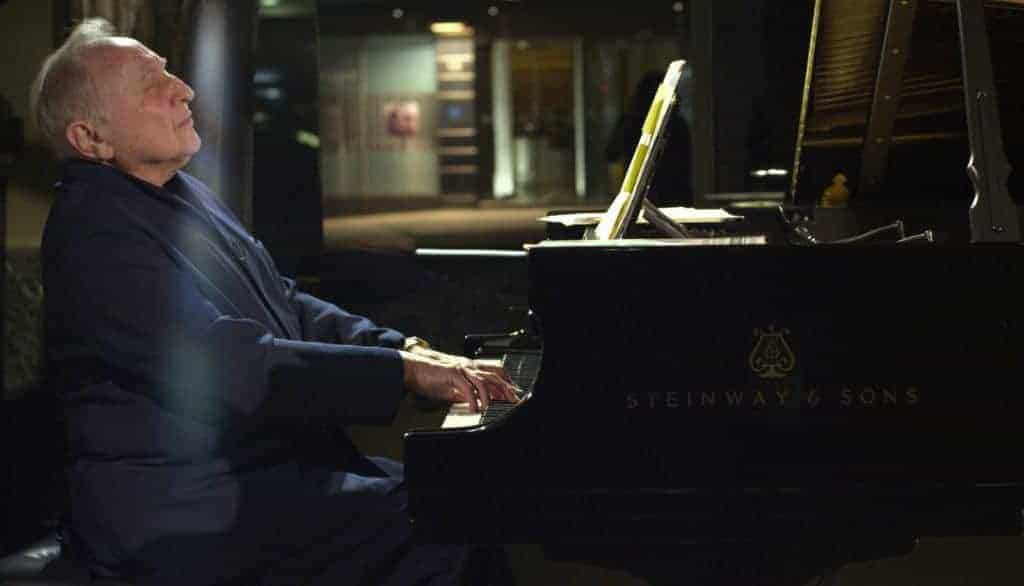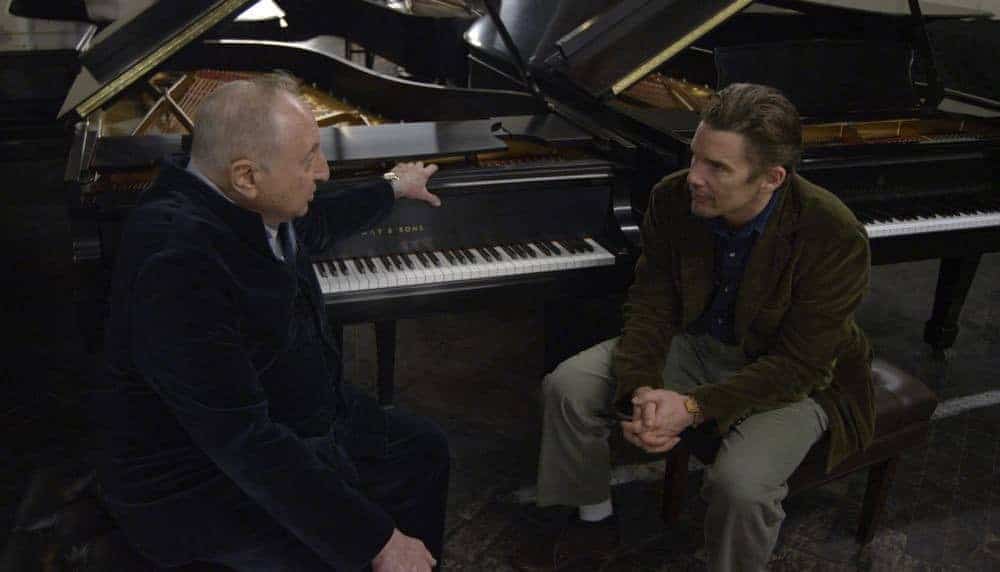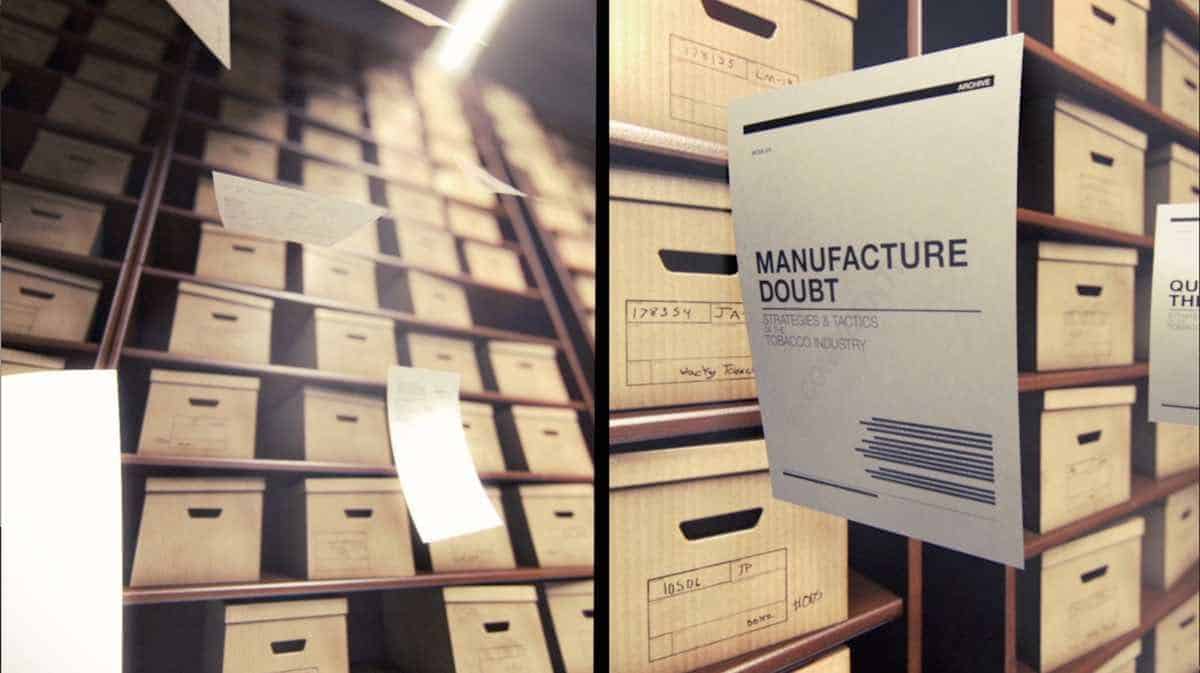In Seymour: An Introduction, Ethan Hawke follows his friend. former concert pianist Seymour Bernstein, for an intimate, inside look at the process of making art, its rewards and struggles, and an ode to a great teacher.
“When my practicing went well, everything else in life seemed to be harmonized by that. When my practicing didn’t go well, I was out of sorts with people, with my parents. So I concluded that the real essence of who we are resides in our talent and whatever talent that there is.”
– Seymour Bernstein

Ethan Hawke’s remarkable debut as a documentary filmmaker, Seymour: An Introduction, is a portrait of one of the greatest concert pianists of the twentieth century, Seymour Bernstein, filtered through the lens of a man of film and theater. The result is an inside look at the process of making art, its rewards and struggles, and an ode to a great teacher. We get a sense of the enormous impact music has had on Bernstein’s life, and in turn, the amazing and touching impact he’s had, through music, on the lives of his students. But the film is as much about the power of music as it is the power of art and of throwing yourself into something you love: your passion and talent, Bernstein muses, is what defines you and sustains you. It is the one constant in a world where social interactions can be unpredictable, where friendships can dissolve almost unexpectedly.
Despite a thriving career as a classical pianist, Seymour Bernstein went into early retirement decades ago, opting instead to dedicate his life to teaching. He recounts becoming paralyzed with stage fright and found giving concerts to be more stressful than pleasurable. He describes what it was like through an anecdote about Sarah Bernhardt signing autographs with a shaky hand before a show, when a young actress, noticing her shaky hand, asked her, “Why is it that I never get nervous before a show?” Bernhardt replied, “My dear, when you learn how to act, you will!” Although Bernstein continued to get rave reviews, all he could focus on were the mental and physical blocks he had on stage: he recounts it all with such humility, none of it false. He couldn’t meet his own high standards, and the stress was too much to continue. He opted, instead, to dedicate his life to teaching. He would play for pleasure, for himself, like an amateur, in the same one-room apartment he’s now lived in for 57 years, with his Steinway grand next to his pull-out couch.
It’s because he’s such a skilled teacher that he’s able to articulate and illuminate the technical details of his craft so well. It makes the film a more penetrating look at the creative process than the equally fascinating but more opaque documentary Gerhard Richter Painting. As Bernstein sits at the piano practicing, Hawke trains his camera on the 87-year-old Bernstein’s still dexterous hands. Bernstein narrates the choices he’s making. What does he need to do to be able to reach the next note? Which notes should he choose to highlight and which should he choose as decoration? You can’t infuse every note with deep emotion, he counsels. He talks us through his decisions, and through his deliberations. We watch bits and pieces of lessons with his students, during which he shares wisdom and offers minor adjustments – relax your shoulders so that your energy goes into the keyboard, raise your arm, don’t play the staccatos as an attack — which help them make major changes in the emotional content, the ultimate goal, of what they’re playing.
Bernstein emphasizes, again and again, the hard work that goes into getting things right. At one point, he recalls that when he felt he was an inadequate pianist, practicing four hours a day, he decided he must need to practice eight hours a day. So that’s what he did. Part of why Bernstein is so dedicated to helping his students thrive is because he understands how important mastering one’s talent is to achieving a positive sense of self: he knows what it feels like to excel at the thing you love most, and he wants to share that. He also recalls the flip-side: when he felt like an inadequate pianist, he also felt like an inadequate person.
In a masterclass at New York University, Bernstein listens to a young woman playing a piece at the piano on stage; the music is projected onto a screen behind her. When she’s finished, he uses a laser pointer to point to a particular bar she’s played, and they discuss the two notes that are slurred and the two notes that she played with a slur that aren’t marked with a slur: this may sound like very technical speak, but Bernstein is getting at something deeper. Each mark in a piece of music is a clue from the composer, a direction about the emotional content of the piece.
What Bernstein is doing here is not so different form what John Barton did with Shakespeare’s verse in the television series Playing Shakespeare: getting technical to find the emotional cues. Bernstein is an expert at linking the technical to the emotional, and Hawke, an actor, a writer, and a director, takes every opportunity to highlight these connections. When we hear the young woman play the musical passage again, we can hear new meaning in it now that she’s adhering to the composer’s directions.
Of course, sometimes you have to read between the lines. And that’s a recurring topic of discussion between Bernstein and his students: how do you interpret a piece when the composer gives you no directions? And at what point are you infusing the piece entirely with your own eccentricities, as Bernstein accuses Glenn Gould of doing with Bach, instead of honouring the composer’s original intentions, while imbuing it with your emotional interpretation? It’s an open question, and Bernstein by no means suggests that his opinion is gospel, but it’s one the film returns to time and again to explore.

Seymour: An Introduction proves an accurate title: it’s a portrait but not an exhaustive one. The film doesn’t attempt to fill in every biographical detail, but it is rich in the stories of Bernstein’s life, from his somewhat difficult childhood, with a father who couldn’t accept his emotional son for who he was, to the larger-than-life stories of his first patroness who sponsored his European debut and housed him in a Tudor mansion in Scarsdale for a year, before falling suffocatingly in love with him. Bernstein tells us about his mentors, his discovery of the piano, and the first time he played “Serenade” by Schubert one Sunday morning at home as a boy: it brought him to tears, it was so beautiful. Bernstein recounts these intimate stories in closeup from the comfort of his own apartment.
Perhaps his most awe-inspiring story is of his time as a conscript in the Korean war; he attributes his ability to survive the 20-mile forced hikes, through -17ºC weather, to the discipline he developed as a musician. But the real heart of the story is that while in Korea, he met a great violinist. When he asked his commanding officer if they could give a concert to the men, the officer was skeptical that the soldiers would have any interest in classical music, but agreed, and they were such a hit, that they were sent on a concert tour on the front lines. They would play serious music to men who may have never heard classical music in their lives — men who would weep, overwhelmed with the emotion. Recalling the story brings Bernstein to tears as he recalls the body bags he saw on this tour, a painful memory he’d managed to suppress until now.
Hawke only inserts himself into the film twice, but these are key moments that help us understand how his fingerprints are all over the film in subtle but key ways. The first time is near the beginning of the film, giving a speech at a concert, Bernstein’s first “public” appearance in years, an intimate affair for Hawke’s friends. He’s telling his guests about how he first met Bernstein at a dinner party hosted by a friend. They were sitting next to each other, and he felt immediately comfortable sharing with Bernstein his deepest insecurities about his craft and why he does what he does. Bernstein helped him understand his art in a way nobody in his profession could.
The second is in a conversation that treads on similar ground but this time Hawke and Bernstein are alone in the piano room at Steinway Hall. They’re preparing for the concert, and Bernstein’s in the process of selecting a piano. The selection process is one of my favourite scenes in the film — he explains his criteria, turns his nose up in disgust at one piano and falls in love with another — giving us insight into Bernstein the professional performer.
In a quiet moment, Hawke and Bernstein sit alone together at a piano talking, Hawke on the verge of tears, expressing his fears about what he’s doing with his life. We see his vulnerability with Bernstein. And as they walk away, side by side, down a hallway in a two-shot, we come to understand the deep friendship and bond that must have formed between the two men to have permitted Bernstein to speak to Hawke on camera with such candour and intimacy. We aren’t just experiencing Bernstein; we’re experiencing Bernstein’s friendship with Hawke, and by proxy, what it’s like to have your life changed and shaped by Bernstein.
Early in the film, Bernstein goes to lunch with one of his students of many years, Michael Kimmelman, now a New York Times columnist, whom he’s been teaching since Kimmelman was five. Like all of Bernstein’s students that we meet in the film, Kimmelman looks at him with great warmth and admiration. He recalls seeing Bernstein perform for the first time with joy and awe, a life-changing performance; Bernstein recalls only the stage fright, as if the concert were just another day. Kimmelman wonders if Bernstein owes it to the world to share his gift as an artist by giving concerts, even if he doesn’t enjoy it. Bernstein reasons that he shares his gift in a different way, through teaching.
At one point, Bernstein says, “The most important thing that music teachers can do for their students is to inspire and encourage an emotional response, not just for music but for all aspects of life.” Near the end of the film, one of his current students explains, with deep emotion and gratitude, almost on the verge of tears, what it’s like to learn from Bernstein: “Seymour showed me what a musician could be. Because I had no idea. I hadn’t heard it. I hadn’t encountered people in my life that were serious about music in the way he was serious about music.” Bernstein sits quietly in the background, but his eyes are alive with gratitude for having made a difference: he’s so pleased to have helped this young man. Although Bernstein has chosen to live a solitary existence, the lives he’s touched through his teaching are many. With this film, Hawke has given the world the gift of being taught to see the world — and music — as Bernstein does, and it’s a great one.
Seymour: An Introduction is now streaming on Netflix.

